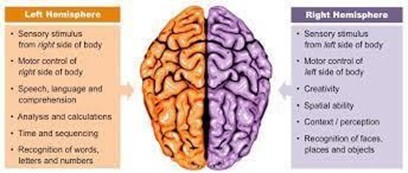A nurse in an emergency department is assessing a client who has experienced a right hemispheric stroke. Which of the following findings should the nurse expect?
Aphasia
Depression
Loss of depth perception
Slow, cautious behavior
The Correct Answer is C
Choice A rationale:
Aphasia, or difficulty with language, is more commonly associated with left hemispheric stroke.
Choice B rationale:
Depression can be a common psychological reaction following stroke, but it is not a specific finding associated with right hemispheric stroke.
Choice C rationale:
Right hemispheric stroke can lead to loss of depth perception and spatial awareness due to its impact on the visual-spatial processing areas of the brain.
Choice D rationale:
Slow, cautious behavior is a common finding after stroke regardless of the affected hemisphere.

Nursing Test Bank
Naxlex Comprehensive Predictor Exams
Related Questions
Correct Answer is A
Explanation
Choice A rationale:
Dry mouth is a common side effect of amitriptyline, which is a tricyclic antidepressant. Informing the client of potential side effects is important for their understanding and management of medication-related symptoms.
Choice B rationale:
Amitriptyline is not known to cause an increase in blood pressure. In fact, it can have a hypotensive effect.
Choice C rationale:
Weight loss is not a typical side effect of amitriptyline. It can often lead to weight gain.
Choice D rationale:
Amitriptyline can cause urinary retention rather than increased urination.
Correct Answer is A
Explanation
Choice A rationale:
Assessing for the client's immediate safety is the first priority in crisis intervention.
Choice B rationale:
Identifying social support is important but not the primary action in this situation.
Choice C rationale:
Instructing the client about coping skills is important, but immediate safety takes precedence.
Choice D rationale:
Exploring the client's perception of the event is valuable, but assessing for suicidality is more urgent.
Whether you are a student looking to ace your exams or a practicing nurse seeking to enhance your expertise , our nursing education contents will empower you with the confidence and competence to make a difference in the lives of patients and become a respected leader in the healthcare field.
Visit Naxlex, invest in your future and unlock endless possibilities with our unparalleled nursing education contents today
Report Wrong Answer on the Current Question
Do you disagree with the answer? If yes, what is your expected answer? Explain.
Kindly be descriptive with the issue you are facing.
